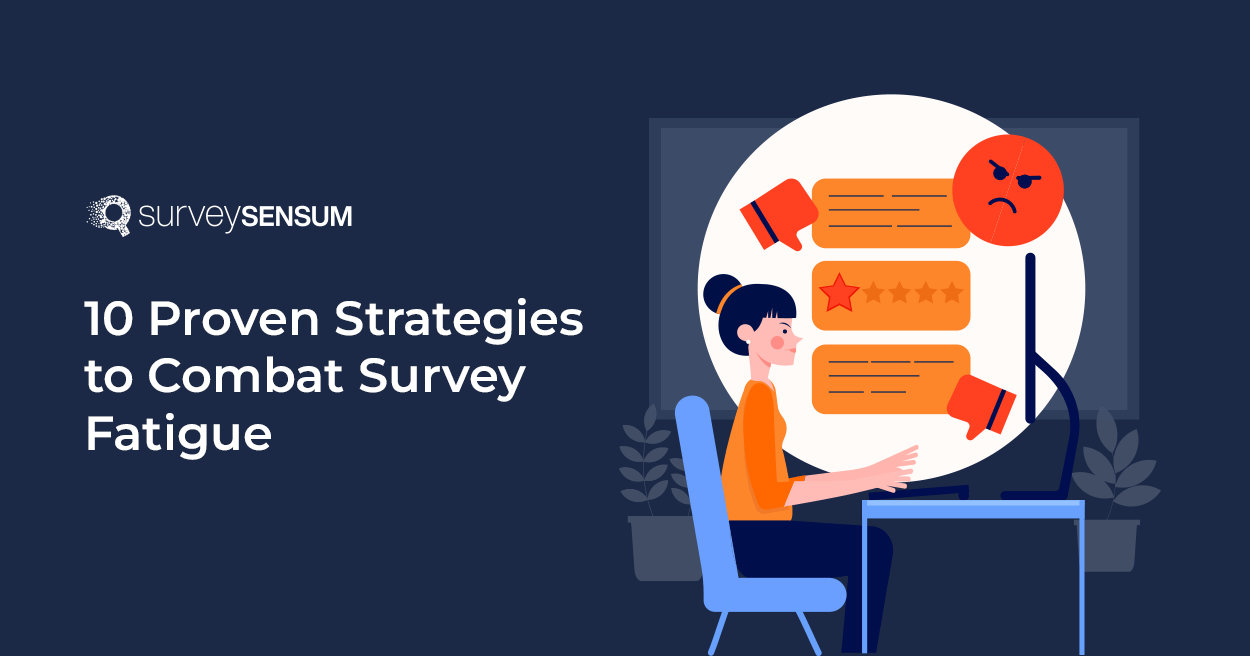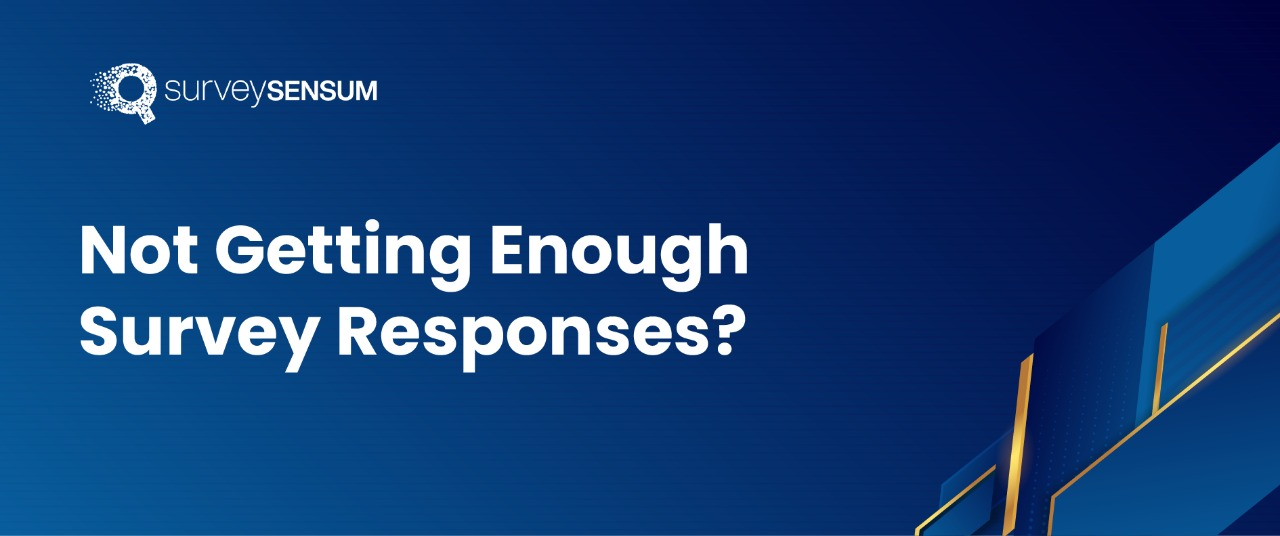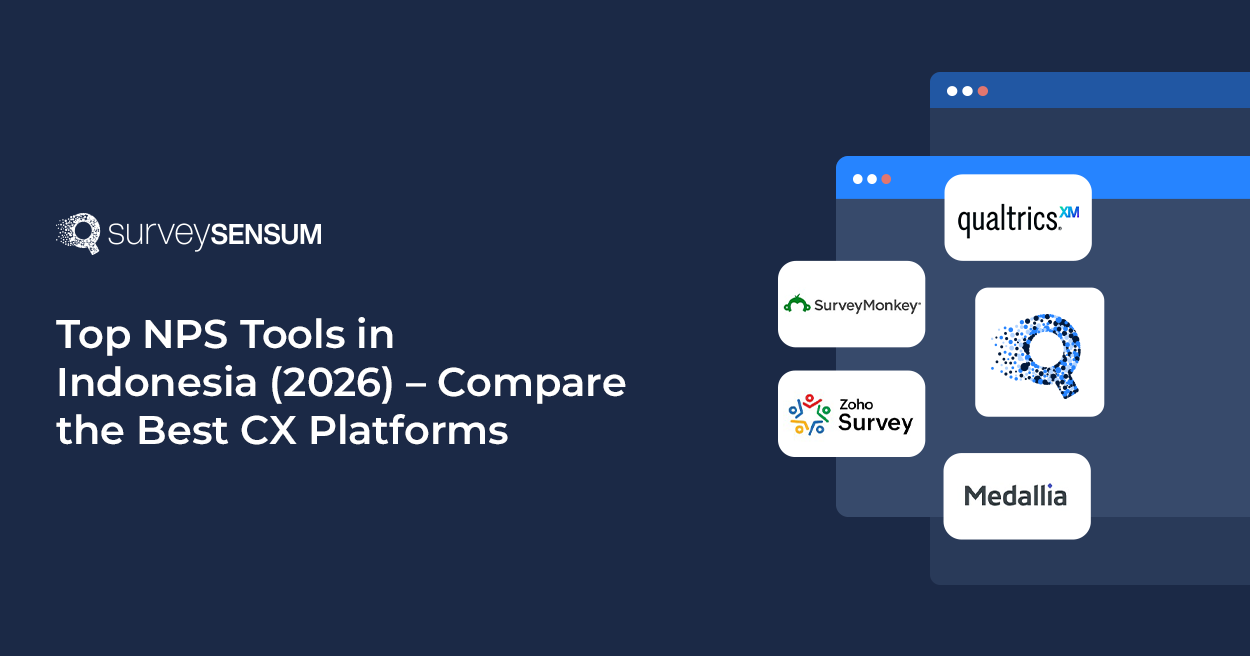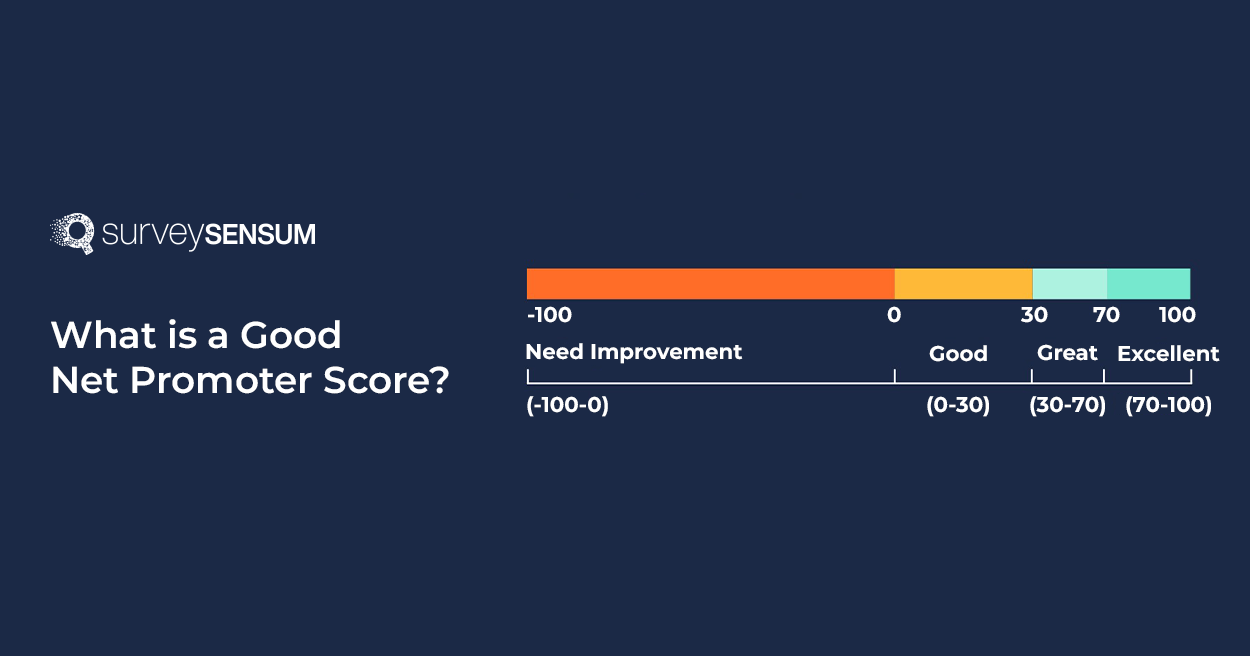

Let’s say you are a dedicated middle school teacher. One day, you receive an email from the school district’s administration asking you to complete a teacher feedback survey urgently.
However, as you start the survey, you quickly realize it’s lengthy and time-consuming, estimated to take 30 minutes of your time. Now frustrated you rush through the survey, providing brief, incorrect answers, which ultimately diminishes the quality of her feedback.
Now, would you have filled out a survey that would have taken 30 minutes of your time?
No, right?
No one does.
This scenario mirrors a common issue called – Survey Fatigue.
What is Survey Fatigue?
Survey fatigue is the feeling of frustration that people experience when they are asked to take too many surveys.
It’s like that feeling you get when your email inbox is flooded with survey requests, and you’re just like, “Not another one!”. It leads to your respondents losing interest and abandoning surveys or providing inaccurate or incomplete information.
But is it really that important?
Well yes. Let’s talk about it.
How Does Survey Fatigue Affect Survey Results?
Survey fatigue can have a real impact on the quality and reliability of survey results, and here’s how it plays out:
- Inaccurate or Incomplete Information: When people are tired of surveys, they rush through the questions, not putting much thought into their answers. This leads to inaccurate or incomplete responses. This can lead to skewed findings and decisions based on shaky ground.
- Abandoned Surveys: Some respondents may even throw in the towel and abandon the survey halfway through. They start with good intentions but give up because it’s too long or frustrating, leaving you with missing data.
- Lower Data Quality: As people get tired of surveys, they might not pay as much attention to detail. So, the quality of the information you collect will suffer, and that’s not good news if you’re trying to make important decisions based on that data.
- Negative Perception: Beyond the survey itself, there’s a risk that people start viewing your brand or organization negatively. They might think, “Ugh, they’re always bothering me with surveys,” and that’s not the impression you want to leave.
- Loss of Trust or Unsubscribing: In extreme cases, survey fatigue can erode trust. People might start unsubscribing from your communications or avoiding your brand altogether because they’re tired of being surveyed.
So, it’s crucial to strike a balance between gathering valuable information and not overwhelming your audience with too many surveys.
Now, that we understand how survey fatigue affects your survey results, let’s delve into the factors contributing to this scenario.
Why Does It Happen?
Hubspot conducted a study among 158 respondents to find out the reason behind their survey abandonment. Here are the top reasons for people abandoning their survey:
- 23.4% of respondents said that they abandon surveys if it’s too long.
- 8.2% of respondents said that the survey questions made them think too deeply.
- 7.0% of respondents said that the survey UX took too much time to navigate.
- 10.8% of respondents said that the survey they didn’t feel motivated enough to answer about the topic.
- 8.9% of respondents said that they were unsure about the impact of their response.
- 4.4% of respondents said they were tired of staring at their phone/computer screens.
- 37.3% of respondents cited other reasons.
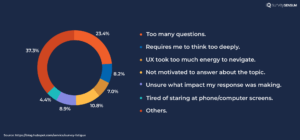
This study shows the different reasons why people abandon surveys midway. But how to combat this problem?
How to Combat Survey Fatigue? – 10 Proven Strategies
- Let’s First Talk About Survey Timing
- Let’s Get Clear on Objectives
- Keep It Short, Simple, and Sweet!
- The Art of Well-Designed Surveys
- Testing the Waters: Why You Should Pilot Your Survey?
- Get Personal: Segment Your Audience for Tailored Surveys
- Timing Is Everything
- Let’s Talk About Closing the Feedback Loop
- Boost Survey Participation with Irresistible Incentives!
- Empower Users to Share Feedback on Their Terms
1. Let’s First Talk About Survey Timing
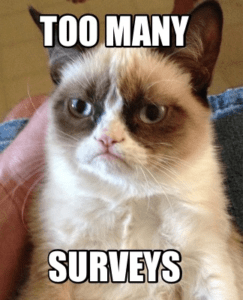
The first step in combating survey fatigue is to evaluate how often you’re sending out surveys and the timing of these surveys.
Here’s what you can do
- Are other departments within your organization also conducting surveys? If yes, how often? – Collaborate with all the teams in the organization to make sure how many surveys are we sending to one customer. You might be sending surveys for multiple reasons but imagine receiving 10 surveys a month.
Then prioritize your objective and minimise the frequency of the surveys.
- What is the survey frequency of your competitors? – Along with doing an internal survey, do a quick research on your competitor’s survey frequency to see if you are matching that frequency or not.
Now, for surveys for B2B companies, the frequency can vary. You can send surveys on a quarterly basis or you can align the frequency with your customers’ engagement patterns.
But for transactional surveys, such as post-purchase surveys, the size of it should be kept concise. Limit these surveys to no more than four questions. This is because customers are more likely to complete short, focused surveys without feeling overwhelmed, especially when they’ve recently engaged with your company.
2. Let’s Get Clear on Objectives

Did you know that 8.9% of survey respondents drop out of surveys because they don’t think there’s a purpose to it or their response will have any impact?
That’s why before creating a survey, it’s crucial to clearly define what is it that you want to achieve. And COMMUNICATE that properly l to your customers
And yes, these objectives should align with your broader business goals.
For example, if your goal is to improve the support of the online shopping experience, your survey objectives might include measuring customer satisfaction post-support calls.
3. Keep It Short, Simple, and Sweet!
Did you know that customers are more inclined to engage with and complete surveys that are concise and don’t demand too much of their time?
This is why the ideal length of survey length should fall within 5 minutes, with respondents willing to answer around 4-5 survey questions. This is because people have limited time and attention spans.
Follow these tips to create short and relevant surveys:
- Prioritize your questions based on their importance and relevance to your survey goals. Begin with the most critical questions, and if you find that the survey is too long, consider whether additional questions are truly necessary or not. .
- Use skip logic to tailor the survey to the respondent’s previous answers, so they only see questions that are relevant to them.
- Before launching a survey, test it with a small group of users to gauge how long it takes to complete.
- Acknowledge the respondent’s effort and express gratitude for their participation, which can increase the likelihood of future survey engagement.
4. The Art of Well-Designed Surveys
Surveys should look clean, engaging, and professional. A visually appealing design makes a positive first impression on respondents and signals that you’ve put effort into creating a quality survey.
Here’s how you can ensure that:
- White Labeling: Customize the survey’s appearance to align with your brand identity. This can include adding your logo, using your brand colors, and customizing fonts to match your branding.
- Avoid Jargon and Complex Terminology: Review your survey questions and remove any jargon, technical terms, or industry-specific language that may not be familiar to your target audience. And replace them with simpler, more understandable language.
- Use Clear and Concise Language: Ask your survey questions such that Each question conveys its intent without ambiguity. Test your questions with a sample audience to ensure they are easily understandable.
- Mobile Friendly: Optimize your survey layout for mobile devices. Use a responsive design that adapts to various screen sizes.
- Easy Input Fields: Simplify input fields and make them user-friendly. For example, radio buttons for single-choice questions, and checkboxes for multiple-choice questions. Minimize the need for free-text input when possible.
By implementing these actionable pointers, you can create surveys that are user-friendly, accessible, and aligned with your brand identity. This will minimize confusion and maximize respondent engagement.
Create Surveys that Drive Results – Sign Up Here!
5. Testing the Waters: Why You Should Pilot Your Survey?
Pilot testing is a crucial step in the survey design process. It allows you to test out different question types, survey timings, and any potential issues before sending out your surveys to a larger audience.
Here are a few actionable tips on how to conduct effective pilot testing:
- Choose a small sample of individuals who closely resemble your target audience. This group should represent the demographics, behaviors, and characteristics of your intended respondents.
- Pay attention to how long it will take to complete the survey and communicate that to the customer. But make sure that If you claim that the survey can be completed within 3 minutes then it should take no more then 3 minutes to complete it.
- Test the effectiveness of different question types. For example, Multiple-choice questions are the quickest, while open-ended questions take effort and are time-consuming.
- Based on the feedback and data from the pilot test, make any necessary adjustments to the survey. This may include revising questions, reordering them, fixing technical glitches, or shortening the survey.
By following these tips you can ensure that your final survey is well-structured, user-friendly, and capable of collecting accurate and meaningful data from your target audience.
6. Get Personal: Segment Your Audience for Tailored Surveys
Every audience is diverse, with varying interests, behaviors, and needs. So segment your customers. This will help you tailor your survey to address specific preferences and concerns of that particular segment, increasing the relevance of your surveys.
For instance, you run an e-commerce store selling a wide range of products. You segment your audience based on their purchase history and product category preferences. Customers who frequently buy electronics are in one segment, while those who often purchase clothing are in another.
You send personalized surveys to each segment. For the electronics segment, you ask about their satisfaction with recent electronic purchases and inquire about specific product preferences. For the clothing segment, you inquire about their fashion preferences and the online shopping experience for clothing. Let’s say if they’re looking for semi-casual attire; you can suggest casual cocktail attire for men or different clothing options based on their preference.
Now, after segmentation, you can focus on personalizing your surveys. When inviting respondents to take the survey, use personalization tokens to address them by their names and mention their past interactions or preferences. This personal touch can encourage participation.
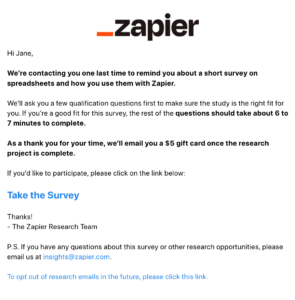
For example, this survey from Zapier addresses the respondent by their name and also incentivizes the respondent with a gift card. This type of personalization will definitely boost survey engagement.
7. Timing Is Everything
Sending surveys at the right times is a critical element in survey design and can significantly impact the quality of the responses you receive. Here are some key considerations related to survey timing:
- Surveys should be conducted at a time when the topic or subject matter is relevant to the participants.
For example, if you are conducting a customer satisfaction survey for a product, it’s best to send it shortly after a customer has used the product rather than months later when their experience may have faded from memory.
- Some surveys, such as annual performance reviews or quarterly financial reports, are tied to specific time intervals and follow cyclic patterns. These should be conducted consistently to allow for meaningful year-over-year or quarter-over-quarter comparisons.
- If your survey has a global audience, be mindful of time zone differences to ensure that participants have a fair opportunity to respond.
- Be mindful of what type of survey you are sending at what touchpoint of your customer journey.
For example, if you send an NPS survey asking about the likelihood of recommending your product right after the delivery instead of sending a CSAT survey to ask about the delivery experience, then the customer will simply ignore it or respond inaccurately.
So, here’s how you can ensure that you are sending your surveys at the right time:
- Post-Interaction Surveys: For transactional surveys or feedback related to specific interactions (e.g., after a purchase, customer support call, or website visit), aim to send the survey immediately after the interaction.
- Customer Journey Mapping: Map your customer’s journey and identify key touchpoints or moments where a survey could provide valuable insights. Align your survey timing with these touchpoints to gather relevant feedback.
- Event-Based Surveys: If you’re conducting surveys related to events or specific occasions (e.g., a product launch or a conference), send them during or immediately after the event to gather timely feedback while the experience is still fresh.
- Seasonal Surveys: Consider seasonal or periodic surveys that align with industry trends or annual events. For example, an annual customer satisfaction survey at the end of the year.
- A/B Testing: Consider conducting A/B testing with different timing strategies to determine which timing yields the best response rates and data quality. This can help refine your approach over time.
By prioritizing timing in your survey strategy, you can ensure that your surveys are well-received, relevant to respondents, and provide you with actionable insights that can inform your decision-making and improve customer satisfaction.
8. Let’s Talk About Closing the Feedback Loop
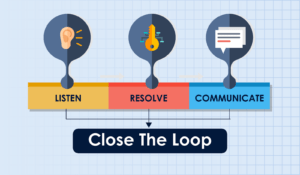
According to a study conducted by McKinsey, it was found that the number one driver of survey fatigue was the perception that the organization wouldn’t act on the results.
This highlights the importance of acting on the feedback gathered from the surveys and informing your customers about the action taken on the feedback given by them.
So Close the Feedback Loop
Closing the feedback loop demonstrates your commitment to acting on the feedback received. It involves not only collecting feedback but also communicating back to respondents about the actions taken based on their input.
Here’s the right way to implement it:
- As soon as you receive feedback, acknowledge it promptly. This can be an automated email response for online surveys or a thank-you message for feedback submitted through other channels.
- Review and analyze the feedback received to identify trends, common themes, and areas where action is needed. Prioritize feedback based on impact and feasibility. – link to TA
- Prioritize the feedback Share it with the relevant teams
- Develop an action plan that outlines the specific steps you will take in response to the feedback. This plan should include timelines and responsible parties for each action.
- Once you have implemented changes or improvements based on the feedback, communicate these actions to the respondents who provided the feedback. This can be done through email updates, newsletters, or other appropriate channels.
- Be transparent about the actions taken and provide specific details. Explain how the feedback influenced these actions and how it will benefit the respondents and the broader audience.
Closing your feedback loop enhances trust, fosters engagement, and ultimately strengthens your relationship with your customers.
Boost Satisfaction by Closing the Feedback Loop Efficiently
9. Boost Survey Participation with Irresistible Incentives!
Incentivizing your customer for their response is a powerful tool to boost survey participation and engagement.
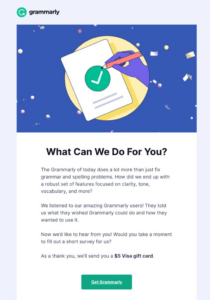
Take this example of Grammarly. Here, Grammarly not only asks for feedback from its users but also incentivizes them by offering them a Visa gift card. This incentive will surely motivate users to respond to the survey with their honest and accurate responses.
Offering incentives, even small ones, can be a highly effective way to simultaneously increase survey response and completion rates.
You could offer:
- a trial period, such as two extra weeks to explore premium features, which is an enticing incentive for users of your software or service.
- discount on subscription fees is an excellent incentive for existing customers or potential subscribers. It not only encourages survey participation but also fosters customer loyalty and satisfaction by reducing costs.
- free months of service can be a strong incentive, especially if your software or tool helps businesses save money or boost their operations.
In addition to these incentives, it’s crucial to communicate the value of these rewards clearly in your survey invitations and throughout the survey process.
Transparency and clarity regarding what respondents will receive in exchange for their feedback can further boost engagement and response rates.
10. Empower Users to Share Feedback on Their Terms
Allowing users to provide feedback whenever they want empowers them to voice their opinions and concerns when it’s most convenient and relevant for them. This can lead to more candid and thoughtful responses.
On-demand feedback also ensures that you capture insights at the moment of experience. This is particularly valuable for transactional feedback or situations where users have just interacted with your product or service.
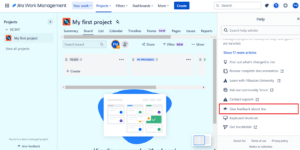
Take the example of Jira. Its non-intrusive in-app survey model allows users to choose when they would like to offer feedback. You can find the option to give feedback under the ‘Help’ section, click on it, and you will guided to a new screen to provide your feedback there. As simple as that!
By making it easy for users to provide feedback, you demonstrate your commitment to their satisfaction and the continuous improvement of your offerings, thereby enhancing the overall user experience.
Conclusion
Surveys are a great way to collect valuable feedback from your customers. But more often than not, businesses make the mistake of bombarding their customers with surveys, making the customers feel frustrated and unmotivated to give feedback.
With the 10 proven strategies provided above you can easily combat survey fatigue. And ensure that your customers have a good experience with your survey and you get the most accurate and honest responses from your customers.
Along with following the strategies discussed above, you also need to employ an efficient customer feedback tool like SurveySensum. This tool will help you create well-designed surveys and also keep track of when and what surveys you are sending and to whom so that you can keep track of your overall survey process.






